
Caulanthus inflatus, the desert candle, also referred to as squaw cabbage, is a flowering plant in the family Brassicaceae, native to the Mojave Desert of California and Nevada, and the southern Sierra Nevada and Transverse Ranges in the United States. It is found at elevations between 150–1,500 metres (490–4,920 ft).
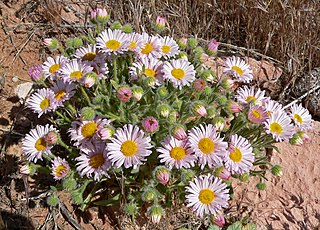
Erigeron concinnus, the Navajo fleabane, tidy fleabane or hairy daisy, is a perennial flowering plant in the family Asteraceae.

Eriophyllum lanosum, the white woolly daisy or white easterbonnets, is a spring wildflower in the family Asteraceae. It grows in the eastern Mojave Desert and the Sonoran Desert in the southwestern United States and northwestern Mexico.

Chaenactis xantiana, the Mojave pincushion or Xantus pincushion, is a flowering plant in the family Asteraceae, native to the western United States, from southeastern Oregon, Nevada, southern and eastern California and northwestern Arizona. It is very common in the Antelope Valley in the Mojave Desert, and grows in sandy soils.

Gilmania luteola is a rare annual plant in the Buckwheat family (Polygonaceae).
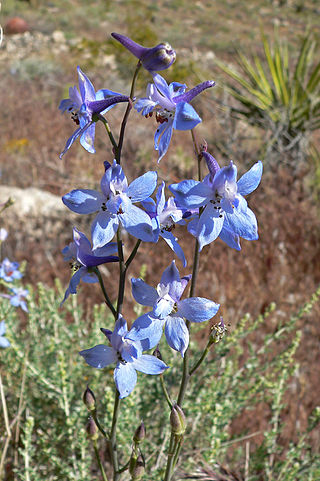
Delphinium parishii, the desert larkspur, is a flowering plant in the family Ranunculaceae native to the Mojave Desert, in the southwestern United States and northwest Mexico. In Southern California it is also found in the Tehachapi Mountains, Transverse Ranges, and eastern Sierra Nevada.

Anisocoma acaulis, commonly known as the scale bud, is a wildflower found in the Mojave, Colorado Deserts, and California's Owens Valley above 2,000 feet (610 m), up to about 7,000 ft (2,100 m).
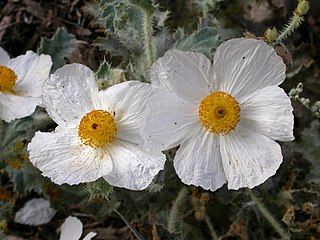
Argemone corymbosa, the Mojave prickly poppy, is a flowering plant in the family Papaveraceae native to the eastern Mojave Desert of the southwestern United States. It especially common around Cima, California and the nearby community of Kelso, California. The plant grows in sandy places and on dry slopes, and is very similar to desert prickly poppy.

Eremalche rotundifolia, the desert five-spot, is a flowering plant in the family Malvaceae, native to the Mojave Desert and Colorado Desert in the Southwestern United States.

Layia platyglossa, commonly called coastal tidytips, is an annual wildflower of the family Asteraceae, native to western North America.

Geraea canescens, commonly known as desert sunflower, hairy desert sunflower, or desert gold, is an annual plant in the family Asteraceae. The genus name comes from the Greek geraios, referring to the white hairs on the fruits.

Chaenactis fremontii, with the common names Frémont's pincushion and desert pincushion, is a species of annual wildflower in the daisy family. Both the latter common name, and the specific epithet are chosen in honor of John C. Frémont.

Balsamorhiza sagittata is a North American species of flowering plant in the tribe Heliantheae of the family Asteraceae known by the common name arrowleaf balsamroot. Also sometimes called Oregon sunflower, it is widespread across western Canada and much of the western United States.

Rafinesquia neomexicana is a species of flowering plant in the family Asteraceae. Common names include desert chicory, plumeseed, or New Mexico plumeseed. It has white showy flowers, milky sap, and weak, zigzag stems, that may grow up through other shrubs for support. It is an annual plant found in dry climate areas of the southwestern deserts of the US and northwestern deserts of Mexico.
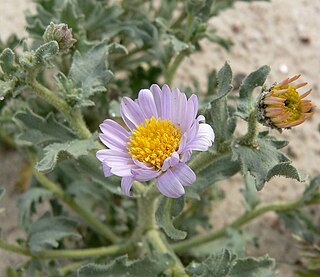
Leucosyris arida is an annual plant in the family Asteraceae, known by the common names arid tansyaster, desert tansyaster, and Silver Lake daisy. It is native to the very arid deserts of northern Mexico and the southwestern United States, and usually looks straggly and not very attractive. But in years with very heavy rainfall, it fills out and becomes rounded and bush like.

Xanthisma gracile is a species of annual flowering plant in the family Asteraceae known by the common names slender goldenweed and annual bristleweed.

Monoptilon bellidiforme is a species of flowering plant in the family Asteraceae known by the common names daisy desertstar and small desert star. It is native to the desert southwest of the United States, where it grows in typical desert habitat such as sandy flats and washes. It is similar to the other Monoptilon, M. bellioides, but it is usually smaller. Its stem is just a few centimeters long, sometimes small enough so that the inflorescence sits at ground level. The leaves are no more than a centimeter long. The flower head has many ray florets which are usually white, sometimes purple-tinged. They are 5 to 7 millimeters long. The fruit is an achene about half a centimeter long including the pappus, which is an elongated bristle surrounded by fused scales.

Ericameria paniculata is a species of flowering plant in the sunflower family Asteraceae, native to the southwestern United States. It is an evergreen yellow-flowered desert shrub.
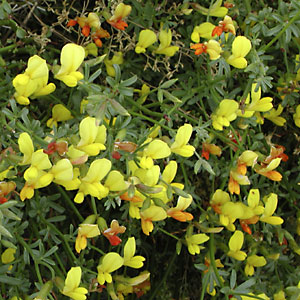
Acmispon rigidus, synonyms Lotus rigidus and Ottleya rigida, is a flowering plant in the pea family (Fabaceae), native to the southwestern United States and northwestern Mexico. It is known as shrubby deervetch or desert rock-pea. It is found in the Mojave Desert and Sonoran Desert.

Funastrum cynanchoides, also known as fringed twinevine, twining milkweed or climbing milkweed, is a perennial plant in the family Apocynaceae that grows twining through other plants in the Mojave Desert and Sonoran Desert. It has milky sap and smells pungent. It is similar to Funastrum hirtellum.




















